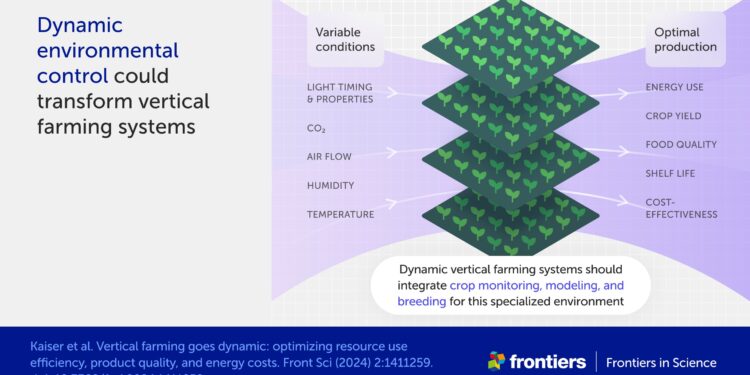Dynamic environmental control could transform vertical farming systems. Credit: Kaiser et al/ Borders
To ensure everyone can eat well in our crowded world, we need to innovate. Vertical farming systems, which intensively grow plants indoors, could be part of the solution. But to use them on a large scale, we need to overcome key challenges, including managing the costly and energy-intensive light that plants need to grow.
Scientists are now demonstrating how manipulating light to suit the needs of specific crops could make them stronger and healthier while minimizing energy use.
“The biggest advantage of vertical farming systems is that healthy food can be grown much closer to consumers in places where it is otherwise impossible: in megacities, in deserts, and in places that are cold and dark for much of the year,” said Dr. Elias Kaiser, first author of the paper. The Frontiers of Science“The biggest challenge is the costs associated with electricity consumption.”
Shedding light on the problem
Many vertical farming systems operate under constant environmental conditions, requiring significant and costly electricity consumption for their maintenance. The scientists’ analysis shows that these demanding conditions are unnecessary: through dynamic environmental control, they suggest, we can achieve more profitable vertical farming that produces healthier plants.
“We were motivated by the rhythms that plants exhibit on diurnal and developmental time scales, which require their growth environment to be adjusted regularly in order to perfectly drive their growth,” said lead author Professor Leo Marcelis of Wageningen University.
“We describe a strategy that uses knowledge of plant physiology, new detection and modeling techniques, and new varieties specifically selected for vertical farming systems.”
Because the biological functions of plants are strongly influenced by environmental conditions such as changes in temperature, wavelengths of light and the amount of CO2 In the atmosphere, manipulation of the environment allows a vertical farming system to manipulate plant development.
Light is a critical variable: all plants need it to photosynthesize, and different wavelengths of light have different effects on different plants. It is also particularly sensitive to the price of electricity, which offers opportunities for efficiency gains.
“Fluctuating electricity prices can be used to the advantage of vertical farming systems, using more electricity when it is cheaper,” Marcelis explains.
The authors created a model to test smart lighting that aims to maintain the plants’ ability to photosynthesize over the course of a day, while reducing electricity costs. They found that an optimization algorithm could reduce electricity costs by 12% without compromising the plants’ carbon fixation, simply by varying the intensity of the light.
They then tested whether variations in light intensity affected the growth of leafy plants like spinach, often grown in vertical farms, and found that there were no negative effects. This remained true even when the plants were subjected to irregular variations in light intensity, rather than a predictable, regular pattern.
Seeds of the future
Other critical issues remain to be resolved before vertical farming can help feed the world.
“Many of the proposed solutions have not been tested at the larger scale that vertical farms represent: they may have been demonstrated at the single plant level, but not yet at the whole crop level,” Kaiser warned.
Dynamic adjustment of air flow, temperature and CO2 Adapting crops to the needs of plants could offer opportunities to minimize electricity costs. Farmers will need adapted sensors and models to help them monitor and adjust the environment, as well as new cultivars bred for vertical farming.
These cultivars could take advantage of the potential for local production under sheltered conditions to focus on better nutritional and sensory qualities, rather than robustness or shelf life. Further research is needed to calibrate all these variables and find the right balance between high-quality and high-yielding crops.
“In a vertical farm, all growing conditions can be precisely controlled, which is very important to optimize yield, quality and resource efficiency,” Marcelis said.
“However, the technical possibility of keeping them constant does not mean that maintaining these values is the best solution. Once dynamic environmental control is established, energy consumption and the costs of the energy used can be significantly reduced, increasing the profitability and sustainability of vertical farms.”
More information:
Vertical farming becomes dynamic: optimizing resource efficiency, product quality and energy costs, The Frontiers of Science (2024). DOI: 10.3389/fsci.2024.1411259
Quote: Scientists study how indoor vertical farming could help meet future food demand (2024, September 24) retrieved September 24, 2024 from
This document is subject to copyright. Apart from any fair dealing for the purpose of private study or research, no part may be reproduced without written permission. The content is provided for informational purposes only.



